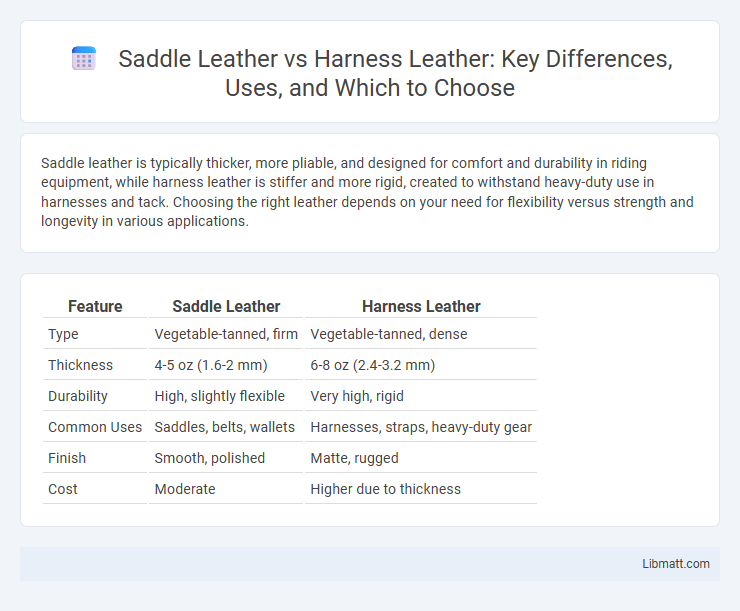Saddle leather is typically thicker, more pliable, and designed for comfort and durability in riding equipment, while harness leather is stiffer and more rigid, created to withstand heavy-duty use in harnesses and tack. Choosing the right leather depends on your need for flexibility versus strength and longevity in various applications.
Table of Comparison
| Feature | Saddle Leather | Harness Leather |
|---|---|---|
| Type | Vegetable-tanned, firm | Vegetable-tanned, dense |
| Thickness | 4-5 oz (1.6-2 mm) | 6-8 oz (2.4-3.2 mm) |
| Durability | High, slightly flexible | Very high, rigid |
| Common Uses | Saddles, belts, wallets | Harnesses, straps, heavy-duty gear |
| Finish | Smooth, polished | Matte, rugged |
| Cost | Moderate | Higher due to thickness |
Introduction to Saddle Leather vs Harness Leather
Saddle leather is a durable, pliable material primarily designed for horse saddles, known for its smooth finish and moderate thickness, providing comfort and flexibility. Harness leather, on the other hand, is thicker, stiffer, and more robust, engineered to withstand heavy wear and weight in horse harnesses and other heavy-duty applications. Understanding the specific characteristics of each leather type helps You choose the right material for your equestrian gear or leathercraft project.
Key Differences Between Saddle and Harness Leather
Saddle leather is typically softer and more pliable, designed to offer comfort and flexibility for horse riding, while harness leather is thicker, stiffer, and more durable, built to withstand heavy-duty use and strain. Saddle leather often undergoes a more refined tanning process, resulting in a smoother finish, whereas harness leather is usually vegetable-tanned, providing greater toughness and resistance to wear. The primary distinction lies in the intended function: saddle leather prioritizes comfort and suppleness, whereas harness leather focuses on strength and long-lasting performance.
Origins and Historical Uses
Saddle leather, traditionally crafted from cowhide, originated for its durability and flexibility, primarily used in Western saddlery and equestrian gear since the 19th century. Harness leather, distinguished by its thick, stiff quality, was developed for heavy-duty applications in horse harnesses and carriage equipment, dating back to early industrial and agricultural societies. Your choice between these two leathers depends on the specific historical context and intended use, as saddle leather emphasizes comfort and wearability while harness leather prioritizes strength and resistance.
Manufacturing Processes Compared
Saddle leather is typically vegetable-tanned using traditional methods that involve prolonged soaking and hand-finishing to achieve a soft yet durable texture ideal for saddlery. Harness leather undergoes a similar vegetable-tanning process but often includes additional treatments like hot stuffing and conditioning with oils and waxes to enhance its rigidity and water resistance. Both leathers are crafted from full-grain cowhide, yet the manufacturing specifics result in saddle leather being more pliable, while harness leather remains stiffer for heavy-duty applications.
Durability and Strength
Saddle leather and harness leather are both crafted from full-grain cowhide but differ in thickness and tanning processes, affecting durability and strength. Harness leather is typically thicker and tanned with heavier oils, making it sturdier and more resistant to wear and tear, ideal for heavy-duty use. Your choice depends on usage; saddle leather offers flexibility and moderate durability suited for equestrian gear, while harness leather provides superior toughness for equipment needing maximum strength.
Flexibility and Handling
Saddle leather offers superior flexibility and softer handling, making it ideal for applications requiring comfort and ease of movement, such as saddles and equestrian gear. Harness leather is stiffer and more durable, designed to withstand heavy stress and maintain shape under pressure, commonly used for heavy-duty harnesses and tack. Your choice depends on whether you prioritize pliability for comfort or rigidity for strength and longevity.
Water Resistance and Weather Performance
Saddle leather typically offers moderate water resistance due to its dense, tightly grained surface, making it suitable for occasional exposure to rain and moisture without immediate damage. Harness leather, crafted from thicker, heavier hides and often treated with oils or waxes, provides superior water resistance and weather performance, maintaining durability and flexibility even under prolonged wet conditions. Both types benefit from proper conditioning, but harness leather's robust treatment ensures enhanced protection against harsh weather and prolonged water exposure.
Common Uses: Saddles, Tack, and Beyond
Saddle leather is commonly used in equestrian gear such as saddles and bridles due to its durability and flexibility, making it ideal for long hours of wear and load-bearing applications. Harness leather, known for its stiffness and high tensile strength, is typically employed in horse harnesses, tack, and heavy-duty straps where maximum support and resistance to stretching are essential. Beyond equestrian uses, both types of leather find applications in crafting belts, wallets, and rugged outdoor gear, valued for their distinctive textures and longevity.
Care, Maintenance, and Longevity
Saddle leather, known for its smooth finish and moderate thickness, requires regular conditioning with saddle soap and leather oil to maintain flexibility and prevent cracking, ensuring long-lasting durability. Harness leather, thicker and stiffer due to its tanning process, benefits from thorough cleaning and periodic application of heavy-duty leather conditioners to preserve its strength and water resistance over time. Proper care tailored to your leather type significantly extends the lifespan of your saddle or harness, keeping them functional and visually appealing.
Choosing the Right Leather for Your Needs
Saddle leather is known for its softness and flexibility, making it ideal for items requiring comfort and ease of movement, such as saddles and upholstery, while harness leather offers superior strength and durability, perfect for heavy-duty applications like belts and harnesses. Your choice should depend on the intended use, as saddle leather ages with a rich patina, enhancing appearance over time, whereas harness leather maintains structural integrity under high stress. Evaluating factors like thickness, treatment, and expected wear will help ensure you select the right leather type for your specific needs.
Saddle leather vs harness leather Infographic

 libmatt.com
libmatt.com